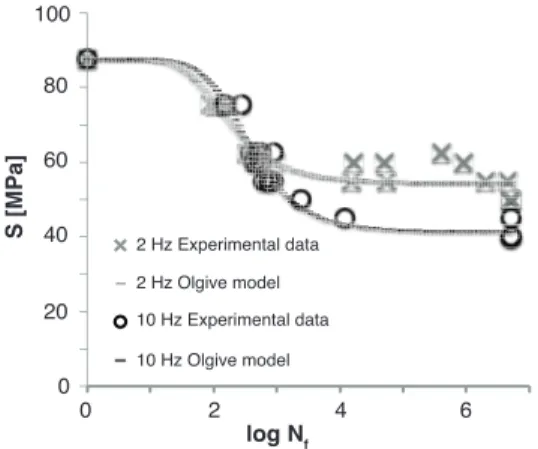http://www.diva-portal.org
Postprint
This is the accepted version of a paper presented at 23rd Interdisciplinary Research Conference on Injectable Osteoarticular Biomaterials in Bone Augmentation Procedures; 8-10 April 2013; Boston, MA, USA.
Citation for the original published paper: Ajaxon, I., Persson, C. (2013)
Compressive fatigue properties of acrylic bone cement for vertebroplasty.
In: The 23rd Interdisciplinary Research Conference on Injectable Osteoarticular Biomaterials in Bone Augmentation Procedures: Proceedings
N.B. When citing this work, cite the original published paper.
Permanent link to this version:
European Cells and Materials Vol. NN. Suppl. N, 20xx (page htu) ISSN 1473-2262
http://www.ecmjournal.org
Compressive fatigue properties of acrylic bone cement for vertebroplasty
I Ajaxon
1,
C Persson
11
Div. of Applied Materials Science
, Dept. of Engineering Sciences, Uppsala University, SE
INTRODUCTION: Acrylic bone cements based
on poly(methyl methacrylate) (PMMA) are commonly used for the fixation of joint prostheses as well as for vertebroplasty. The fatigue properties of the cement are important to the long-term success of the implant, and the ASTM F2118-03 standard for fatigue testing of acrylic bone cements – originally developed for cements used in joint fixations – specifies a fully reversed tension-compression test. However, the same standard is commonly used for testing of cements intended for vertebroplasty, despite the fact that vertebrae mainly experience compressive loads. Until now, purely compressive fatigue studies of PMMA are scarce [1, 2] and none has studied vertebroplastic cement, which e.g. contains a higher amount of radiopacifier. The aim of this study was to evaluate the compressive fatigue properties of vertebroplastic cements, as well as the effect of frequency on these properties. Due to the time consuming character of fatigue tests – the standard cites a frequency of 2 Hz – there is a desire for increasing the frequency to higher values.
METHODS: A commercially available acrylic
cement developed for use in vertebroplasty, Osteopal V® (Heraeus Kulzer GmbH), was used for all tests. The powder phase contains 45 wt% of ZrO2 as a radiopacifier. The powder and liquid
phases were manually mixed, and moulded in cylindrical moulds (6 mm diameter, 12 mm height). The specimens were left to cure at ambient temperature. Prior to fatigue testing, specimens were visually and radiographically examined and samples containing defects greater than 1 mm were discarded. Fatigue testing was performed under ambient conditions with a constant-amplitude sinusoidal wave profile, at a frequency of 2 or 10 Hz, using a dynamic material testing system (MTS Axial 858 Mini Bionix II). Each specimen was subjected to a small pre-load of 20 N, and run-out was set at 5 million cycles. Failure was defined to occur at a cumulative strain of 15%, as vertebral compression fractures are detected at a vertebral height reduction of 15-25% [3].
RESULTS: The S-N curve for the experimental
data together with fits to an Olgive-type equation are shown in figure 1. The statistical analysis of the fatigue results showed significant differences between the tested frequencies at stress levels of
55 and 60 MPa. However, at higher stress levels the diffferences between 2 and 10 Hz were no longer significant. The estimated fatigue limits from the Olgive equations were 54.5 and 41.3 MPa, for 2 and 10 Hz, respectively.
log Nf 60 40 20 0 80 100 2 4 6 0 10 Hz Olgive model 2 Hz Olgive model 2 Hz Experimental data 10 Hz Experimental data S [MPa]
Fig. 1: Applied stress (S) as a function of the number of cycles to failure (Nf).
DISCUSSION & CONCLUSIONS: The fatigue
strengths presented here are lower than previous findings for acrylic cement in compression (CMW1®) [2]. However, the cement composition differs and this will influence the mechanical properties. The results presented here also show significant differences in fatigue properties at different frequencies. It has previously been shown that localized thermal heating of PMMA may shorten the fatigue life of the specimen [1], and increasing the frequency increases the thermal softening of the material. Hence an increase from 2 to 10 Hz may lead to an apparent decrease in fatigue life of acrylic bone cements under compressive loading. The estimated fatigue limit is approximately five times as high as that for the same cement (to the authors’ best knowledge) in full tension-compression at 2 Hz [4]. This indicates that tension-compression fatigue testing may substantially underestimate the performance of cements intended for vertebroplasty.
REFERENCES: 1 D. Rittel (2000) Mech Mater
32: 131–147. 2 K. Serbetci, et al. (2004) Polym
Test 23: 145–155. 3 EN. Schwartz and D. Steinberg
(2005) Curr Osteoporos Rep 3: 126–135. 4 G.
Lewis (2000) J Biomed Mater Res 53: 119-130.
ACKNOWLEDGEMENTS: Funding from VR –
Swedish research council, Vinnova and EU is gratefully acknowledged.
